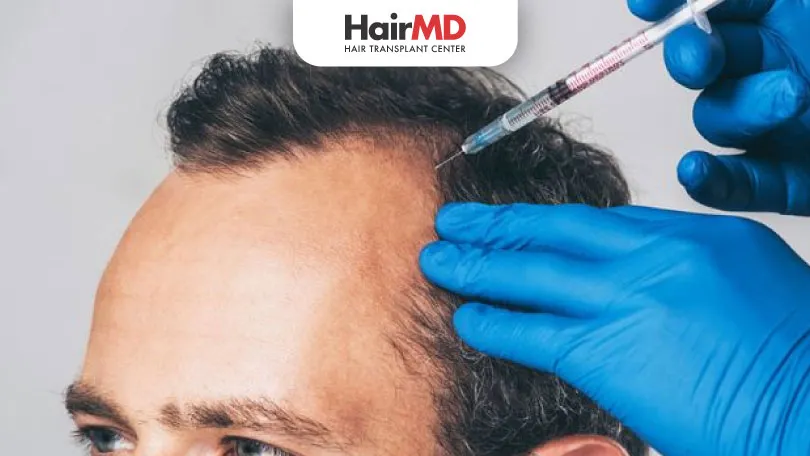1st Dec, 2023

Nowadays, hair loss is a very common phenomenon faced by both men and women. Various treatments are followed to address hair loss. Dermatologists prescribe US FDA approved medications such as Minoxidil and Finasteride. Alongside these medications, some supportive treatments are also effective in managing hair loss. One such treatment is Platelet-Rich Plasma (PRP) therapy for hair loss.
PRP therapy for hair growth utilized for hair growth, is a medical approach aimed at addressing hair loss concerns. Platelet-rich plasma injections may act as a trigger for natural hair growth. Increasing blood supply to the hair follicle maintains this growth and increases the thickness of the hair shaft. Micro-needling and other medical solutions are often combined with PRP to combat hair loss.
What’s covered in the article?
- PRP Treatment Procedure: Steps and Frequency
- PRP for Hair Loss Treatment
- Why Opt for PRP for Hair Loss?
- Advantages of PRP Therapy for Hair
- Side Effects of PRP Therapy for Hair
- Precautions after PRP Injection
- Conclusion
PRP Treatment Procedure: Steps and Frequency
PRP therapy has three steps and may need up to three treatments at an interval of 4–6 weeks. This is then followed by maintenance treatments every 4–6 months..
Step 1:Blood is drawn, generally from the arm, and put into a centrifuge or other specialized device that spins at high speed.
Step 2:The centrifugal forces separate platelets from other blood components. This causes the heaviest particles in the blood, i.e., the red blood cells, to settle at the bottom of the vial. The layer above the red blood cells contains the white blood cells and platelets with plasma. The highest, lightest layer contains a clear solution of blood plasma.
Step 3:After centrifuging, the doctor removes the platelet-poor plasma (PPP) and separates the white blood cells from the platelet-rich plasma (PRP). The doctor then uses this for the therapy.
PRP for Hair Loss Treatment
Generally, the ideal volume of PRP for injecting into the scalp is 8 ml – 12 ml. The concentration of platelet-rich plasma is drawn up into a syringe and then injected into areas of the scalp that are suffering from hair loss.
The doctor marks out the area of hair restoration on the scalp, administers local anesthesia using cream and then disinfects it. The platelet-rich plasma is injected into the deeper layers of the scalp. The site is then cleaned thoroughly.
Why Opt for PRP for Hair Loss?
Blood consists of red blood cells, white blood cells, platelets, and plasma- which is the fluid part of blood. Plasma suspends and carries blood cells and nutrients throughout the body.
Platelets are tiny cells in the blood with various functions in the body. One of the functions is to cause blood to clot to prevent excessive bleeding during injury. Another is to contain proteins in our blood that help wounds to heal.
Platelets are also a reservoir of growth factors. These growth factors stimulate tissue recovery by increasing blood flow and cytokines. They are also responsible for stimulating and enhancing hair follicle function
The PRP injection contains a high concentration of platelets. This is around 5 – 10 times more than the platelets in untreated blood. This helps to reduce the inflammation that may lead to hair loss. Doctors theorise that the platelets speed up healing.
Advantages of PRP Therapy for Hair
- Very minimal side-effects limited to soreness and redness of the skin for a day or two.
- There is little to no downtime after receiving a PRP injection
- Minimally invasive procedure requiring only the injections.
- Quick treatment, usually lasting 60 to 90 minutes..
- PRP therapy eliminates the risk of contracting any communicable diseases as it uses the patient’s own blood.
Side Effects of PRP Therapy for Hair
- There may be tenderness, soreness, pinpoint bleeding at the injection delivery site.
- There may also be a feeling of ‘tightness’ on the scalp for a day after the procedure
- A few patients complain of a headache for a day post of the procedure.
Precautions after PRP Injection
Ensure that you let your doctor know of any medications, including supplements you may be on. You should also inform your doctor of any chronic infections, diseases or illnesses. Your doctor may recommend against PRP for hair loss if you are on blood thinners, are a heavy smoker or have a history of alcohol or drug misuse.
Do You Know?
Nearly 250 Patients Visit HairMD
Everyday For Various Hair Concerns?
(Your journey to healthier and fuller hair starts here!)
Meet Our Dermatologists
Conclusion
Further Reading
Oily Scalp After Hair Transplant and How to Manage It
Oily scalp after hair transplant is common and manageable. Get simple care tips to reduce oiliness and support a smooth recovery.
Can You Get a Hair Transplant Without Shaving Your Head?
Hair transplant without shaving offers a discreet option for restoring hair. This method suits mild hair loss and allows you to maintain your natural look.
Manual Vs Robotic Hair Restoration
Discover the pros and cons of manual vs robotic hair restoration. Learn why manual hair transplants deliver natural results. Consult a hair specialist in Pune today.
Can Rainwater Cause Hair Loss? Understanding the Impact
Find out if Rainwater Cause Hair Loss & how to keep your hair safe during the monsoon season. Expert tips for keeping your hair healthy in rainy weather!
Have thoughts? Please let us know
We are committed not only to treating you, but also educating you.










